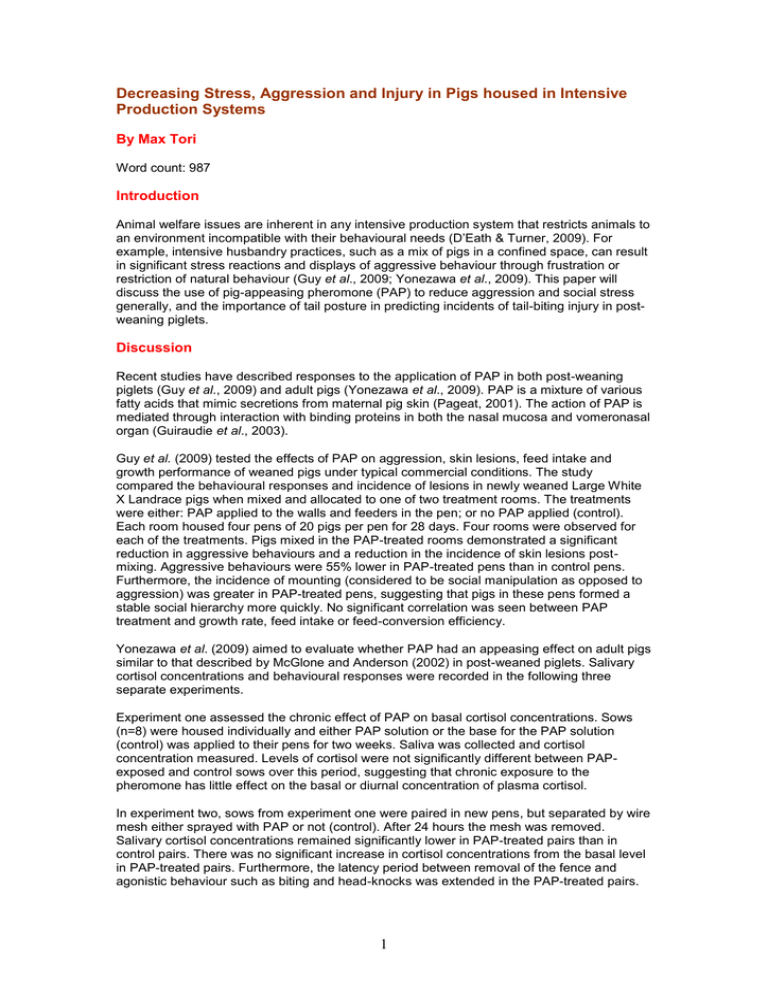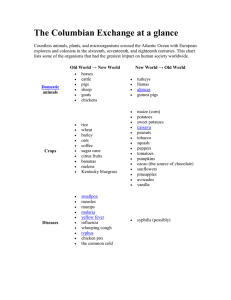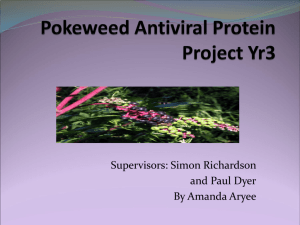1 Decreasing Stress, Aggression and Injury in Pigs housed
advertisement

Decreasing Stress, Aggression and Injury in Pigs housed in Intensive Production Systems By Max Tori Word count: 987 Introduction Animal welfare issues are inherent in any intensive production system that restricts animals to an environment incompatible with their behavioural needs (D’Eath & Turner, 2009). For example, intensive husbandry practices, such as a mix of pigs in a confined space, can result in significant stress reactions and displays of aggressive behaviour through frustration or restriction of natural behaviour (Guy et al., 2009; Yonezawa et al., 2009). This paper will discuss the use of pig-appeasing pheromone (PAP) to reduce aggression and social stress generally, and the importance of tail posture in predicting incidents of tail-biting injury in postweaning piglets. Discussion Recent studies have described responses to the application of PAP in both post-weaning piglets (Guy et al., 2009) and adult pigs (Yonezawa et al., 2009). PAP is a mixture of various fatty acids that mimic secretions from maternal pig skin (Pageat, 2001). The action of PAP is mediated through interaction with binding proteins in both the nasal mucosa and vomeronasal organ (Guiraudie et al., 2003). Guy et al. (2009) tested the effects of PAP on aggression, skin lesions, feed intake and growth performance of weaned pigs under typical commercial conditions. The study compared the behavioural responses and incidence of lesions in newly weaned Large White X Landrace pigs when mixed and allocated to one of two treatment rooms. The treatments were either: PAP applied to the walls and feeders in the pen; or no PAP applied (control). Each room housed four pens of 20 pigs per pen for 28 days. Four rooms were observed for each of the treatments. Pigs mixed in the PAP-treated rooms demonstrated a significant reduction in aggressive behaviours and a reduction in the incidence of skin lesions postmixing. Aggressive behaviours were 55% lower in PAP-treated pens than in control pens. Furthermore, the incidence of mounting (considered to be social manipulation as opposed to aggression) was greater in PAP-treated pens, suggesting that pigs in these pens formed a stable social hierarchy more quickly. No significant correlation was seen between PAP treatment and growth rate, feed intake or feed-conversion efficiency. Yonezawa et al. (2009) aimed to evaluate whether PAP had an appeasing effect on adult pigs similar to that described by McGlone and Anderson (2002) in post-weaned piglets. Salivary cortisol concentrations and behavioural responses were recorded in the following three separate experiments. Experiment one assessed the chronic effect of PAP on basal cortisol concentrations. Sows (n=8) were housed individually and either PAP solution or the base for the PAP solution (control) was applied to their pens for two weeks. Saliva was collected and cortisol concentration measured. Levels of cortisol were not significantly different between PAPexposed and control sows over this period, suggesting that chronic exposure to the pheromone has little effect on the basal or diurnal concentration of plasma cortisol. In experiment two, sows from experiment one were paired in new pens, but separated by wire mesh either sprayed with PAP or not (control). After 24 hours the mesh was removed. Salivary cortisol concentrations remained significantly lower in PAP-treated pairs than in control pairs. There was no significant increase in cortisol concentrations from the basal level in PAP-treated pairs. Furthermore, the latency period between removal of the fence and agonistic behaviour such as biting and head-knocks was extended in the PAP-treated pairs. 1 These results both indicate that the social stress response is inhibited in adult pigs following exposure to PAP. Experiment three was aimed at identifying the effects of chronic PAP exposure on the immune response. Endotoxin (lipopolysaccharide) was injected intramuscularly and plasma cortisol concentration, rectal temperature and behavioural parameters were measured. No significant difference was observed between treatment groups in this experiment. Overall, Yonezawa et al. (2009) demonstrated that PAP can reduce social stress and aggressive behaviours in adult pigs. Some concerns about the significance of these results may be raised due to the use of only 8 sows. However, a crossover design was used to eliminate individual subject differences. The results from both studies mean that pig producers could potentially use PAP to reduce aggressive behaviours and physical injuries in both adult and juvenile pigs. Furthermore, PAP may play a role in promoting pigs’ ability to rapidly form stable social structures. Hence, producers could increase both the physical and psychological welfare of pigs when mixing by using PAP. Further potential applications of PAP may include application during transport (Driessen et al., 2008) or postnatal marking procedures. It is still uncertain whether PAP could be used to increase feed intake, and this warrants further investigation (see McGlone & Anderson, 2002, and cf. Guy et al., 2009). Another interesting recent development is the potential for the observation of tail posture to predict tail damage in weaned piglets. Tail damage through tail-biting in pigs is a significant welfare issue, associated particularly with intensive pig-production systems. Zonderland et al. (2009) aimed to examine whether tail posture could predict tail damage in the pre-injury stage of a tail-biting outbreak, before the tails were bleeding and damaged. Pigs (n=992) were observed three times per week. Observations of tail posture, motion and damage were recorded. The results showed that piglets with their tails between their legs had a significantly higher chance of tail damage two to three days later (P < 0.001) (Zonderland et al., 2009). It is likely that bitten piglets keep their tails between their legs to avoid further injury (Zonderland et al., 2009). If pig producers check tail posture regularly, they may be able to detect outbreaks of tail-biting before significant injuries occur and thereby enhance the welfare of weaned piglets in intensive production systems. Conclusion Potentially, both PAP and monitoring tail posture can be used together to decrease the incidence and seriousness of aggressive behaviours and injury in post-weaning piglets. PAP may also be used to inhibit physiological stress responses in both adult and juvenile pigs and thereby increase welfare in a wide variety of situations associated with intensive pig production. References Driessen, B., Peeters, E., Geers, R. (2008) Influence of olfactory substances on the heart rate and lying behaviour of pigs during transport simulation. Animal Welfare 17:2, 155-160. D’Eath, R.B., Turner, S.P. (2009) The natural behaviour of the pig. In: The welfare of pigs, ed. J.N. Marchant-Forde, Kluwer, Dordrecht, The Netherlands. Guiraudie, G., Pageat, P., Cain, A.H., Madec, I., Nangan-Le Meillour, P. (2003) Functional characterization of olfactory binding proteins for appeasing compounds and molecular cloning in the vomeronasal organ of pre-pubertal pigs. Chemical Senses 28:7, 609-619. Guy, J.H., Burns, S.E., Barker, J.M., Edwards, S.A. (2009) Reducing post-mixing aggression and skin lesions in weaned pigs by application of a synthetic maternal pheromone. Animal Welfare 18:3, 249-255. 2 McGlone, J.J., Anderson, D.L. (2002) Synthetic maternal pheromone stimulates feeding behaviour and weight gain in weaned pigs. Journal of Animal Science 80:12, 3179-3183. Pageat, P. (2001) Pig appeasing pheromones to decrease stress, anxiety and aggressiveness. Official Gazette of the United States Patent and Trademark Office Patents 1242:1. Yonezawa, T., Koori, M., Takefumi, K., Mori, Y. (2009) Appeasing pheromone inhibits cortisol augmentation and agonistic behaviours during social stress in adult miniature pigs. Zoological Science 26:11, 739-744. Zonderland, J.J., van Riel, J., Bracke, M.B.M., Kemp, B., den Hartog, L.A., Spoolder, H.A.M. (2009) Tail posture predicts tail damage among weaned piglets. Applied Animal Behaviour Science 121:3-4, 165-170. 3



